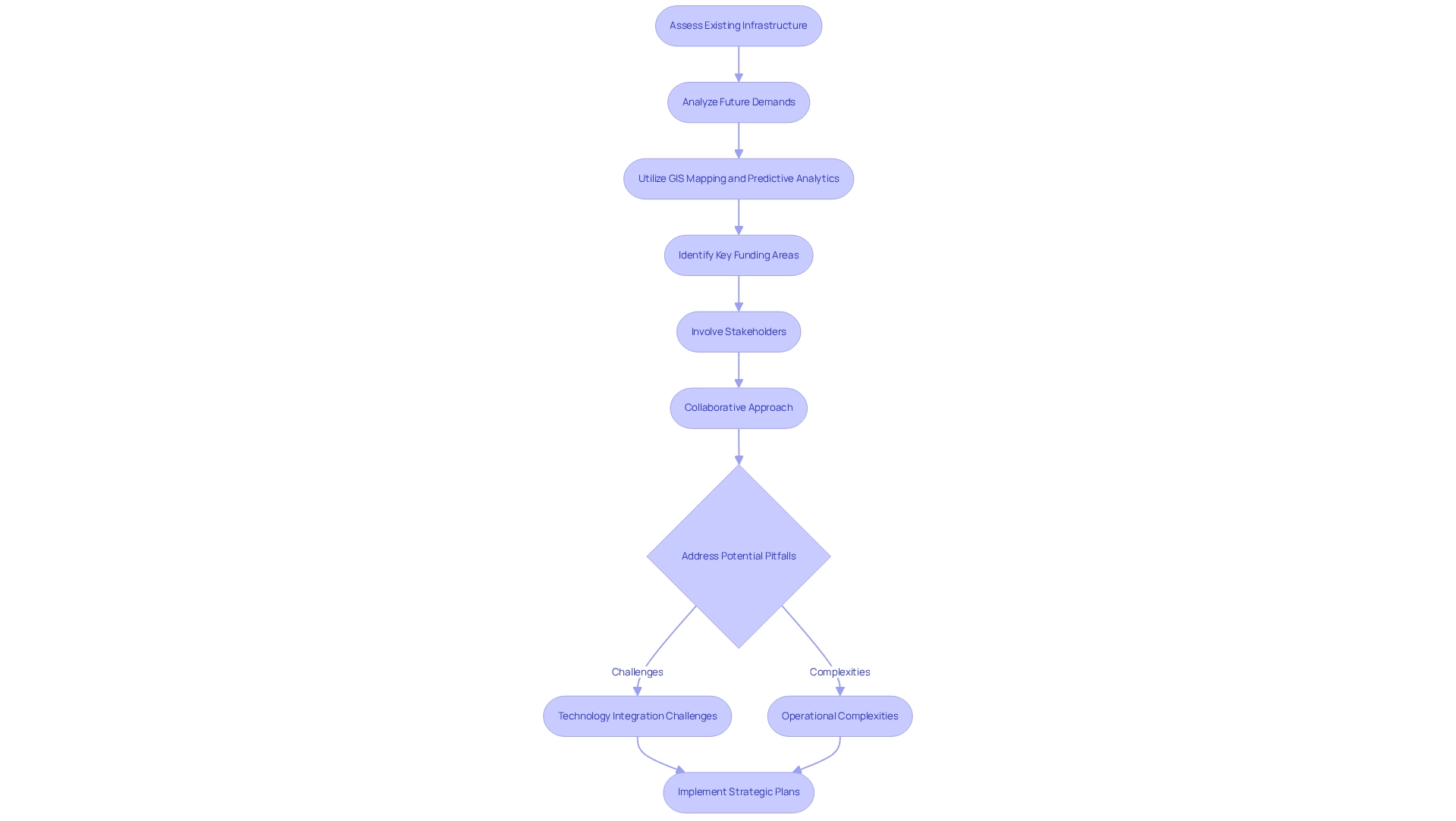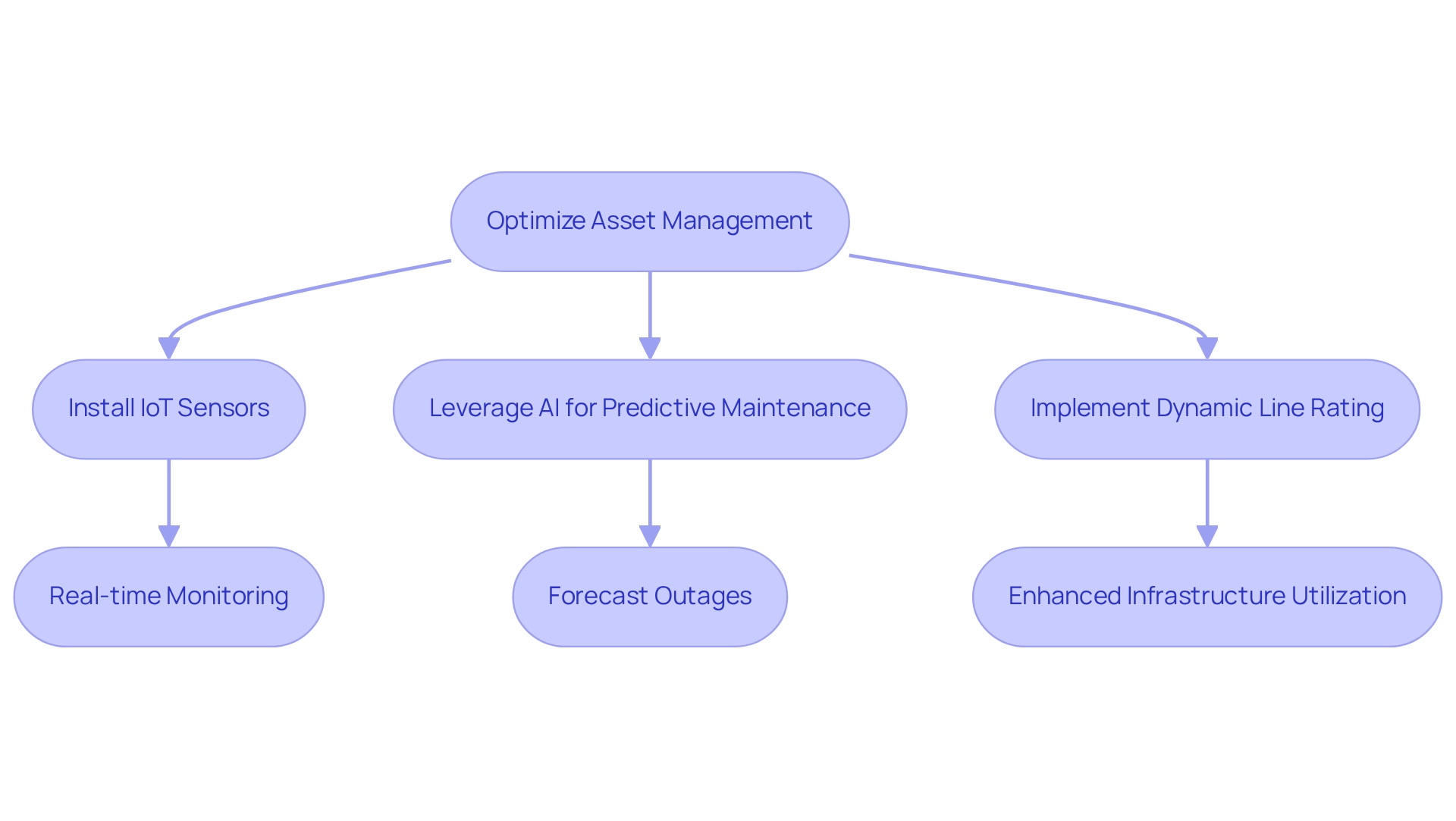Overview
Effective transmission grid asset management is crucial for addressing the complexities of rising energy demands. By implementing strategic investment planning, leveraging advanced technologies, and fostering collaboration among stakeholders, organizations can enhance grid reliability and efficiency.
- Assessing infrastructure needs is the first step;
- Utilizing IoT and AI for predictive maintenance provides a robust solution to minimize downtime and operational costs.
- Furthermore, engaging community stakeholders not only builds trust but also ensures that the grid meets the evolving demands of the population.
Ultimately, these strategies are essential for optimizing performance while effectively managing costs.
Introduction
In an era marked by escalating energy demands and aging infrastructure, the urgency for strategic investment in transmission systems has reached unprecedented levels. Organizations are confronted with the dual challenge of upgrading existing facilities and integrating cutting-edge technologies that improve asset management and promote collaboration among stakeholders.
By harnessing tools such as predictive analytics and IoT sensors, utilities can optimize their operations and guarantee grid reliability, all while navigating the intricate landscape of community engagement and regulatory compliance.
This article explores the comprehensive approach necessary for effective transmission infrastructure planning, underscoring the significance of strategic investments, technological innovations, and stakeholder collaboration in forging a resilient energy future.
Establish Strategic Investment Plans for Transmission Infrastructure
To create effective strategic financial plans, organizations must conduct a thorough assessment of existing infrastructure alongside anticipated future demands. This process includes analyzing energy consumption trends, regulatory requirements, and technological advancements. Employing tools such as GIS mapping and predictive analytics enables companies to identify key funding areas. For instance, a utility may prioritize upgrading aging transmission lines in regions experiencing significant population growth.
Involving stakeholders during the planning phase is essential. This guarantees that funding strategies align with community needs and regulatory expectations. Such a collaborative approach not only enhances project feasibility but also cultivates public support, which is vital for successful implementation. However, organizations must remain cognizant of potential pitfalls, including technology integration challenges and operational complexities, which can hinder effective planning.
Real-world instances, such as the California ISO's 2024-2025 Transmission Plan, demonstrate how transmission grid asset management through strategic funding can enhance grid reliability and capacity without necessitating the creation of entirely new lines. By concentrating on enhancing existing infrastructure, utilities can realize substantial cost savings while effectively addressing rising energy demands. As Elizabeth May noted, "Once you got a solar panel on a roof, energy is free. Once we convert our entire electricity grid to green and renewable energy, cost of living goes down." This perspective underscores the significance of transitioning to renewable energy sources as a component of strategic planning. As utilities face an unprecedented rise in power demand in 2025, strategic funding in transmission grid asset management for power distribution will be crucial for sustaining resilience and operational efficiency.

Leverage Advanced Technologies for Enhanced Asset Management
To optimize transmission grid asset management, organizations must prioritize investments in advanced technologies that facilitate real-time monitoring and predictive maintenance. The installation of IoT sensors on power lines provides ongoing data gathering about their status, enabling prompt actions to avert failures. By leveraging AI algorithms to analyze this data, utilities can forecast potential outages and refine maintenance schedules, effectively minimizing service disruptions.
A significant case study concerning the National Grid demonstrates the benefits of dynamic line rating (DLR) technology, which allows real-time modifications to capacity based on environmental factors. This approach not only enhances the utilization of existing infrastructure but also aids in the seamless integration of renewable energy sources, thereby fostering a more resilient grid. The adoption of such innovative technologies empowers utilities to significantly improve their transmission grid asset management strategies, resulting in enhanced reliability and cost efficiency.
Furthermore, statistics show that the use of IoT sensors in power lines has resulted in a 30% decrease in unplanned outages, demonstrating their efficiency in asset management. Specialists in the area, including Vikram K. Jaswal, stress that these technologies not only improve operational efficiency but also guarantee that the perspectives of involved parties are acknowledged in the decision-making process. Moreover, predictive maintenance has been demonstrated to enhance grid reliability by as much as 25%, underscoring its essential function in transmission grid asset management. By addressing common pitfalls, such as underestimating the importance of data integration, organizations can better leverage these advanced technologies to achieve optimal results.

Foster Collaboration and Negotiation Among Stakeholders
Encouraging cooperation among parties is essential for the success of delivery initiatives. Identifying key players—local governments, utility companies, and community organizations—early in the process is critical. Establishing clear communication channels and shared objectives aligns interests and fosters trust among all involved parties. Regular workshops and meetings facilitate open discussions, allowing participants to express concerns and engage actively in planning.
A notable example of successful teamwork emerged in a recent initiative that brought together various parties to address environmental issues while adhering to regulatory standards. Through transparent negotiations and proactive engagement with affected communities, the team secured necessary permits and garnered public support. This collaborative approach not only expedited the approval process but also significantly enhanced the initiative's overall success, highlighting the vital role of participant involvement in transmission grid asset management.
Statistics reveal that initiatives featuring robust community engagement mechanisms experience improved operational performance and reduced social conflict. By adopting advanced metrics and promoting active involvement, stakeholders can unlock the full potential of their partnerships, leading to sustainable outcomes. As community leaders stress, effective communication is crucial in project planning, ensuring that all voices are acknowledged and valued.

Conclusion
Strategic investment in transmission infrastructure is no longer a luxury; it is a necessity for utilities aiming to meet growing energy demands while ensuring grid reliability. By conducting thorough assessments of existing systems and anticipating future needs, organizations can develop targeted investment plans that prioritize critical upgrades and align with regulatory frameworks. Engaging stakeholders throughout this process not only enhances project feasibility but also fosters public support, essential for successful implementation.
The integration of advanced technologies, such as IoT sensors and predictive analytics, has proven transformative in asset management. These innovations enable real-time monitoring and maintenance, significantly reducing unplanned outages and improving operational efficiency. Case studies highlight the tangible benefits of leveraging these technologies, reinforcing their role in creating a resilient and reliable energy grid.
Collaboration among stakeholders is equally crucial. By establishing clear communication and shared objectives, utilities can navigate challenges more effectively and ensure community needs are met. Successful examples of stakeholder engagement demonstrate that transparent negotiations can expedite project approvals and enhance overall success.
In conclusion, the path toward a resilient energy future hinges on strategic investments, technological advancements, and robust collaboration among stakeholders. By embracing these elements, utilities can optimize operations and contribute to a sustainable energy landscape that benefits all. The time to act is now; the future of energy depends on the proactive steps taken today.
Frequently Asked Questions
What is the first step in establishing strategic investment plans for transmission infrastructure?
The first step is to conduct a thorough assessment of existing infrastructure alongside anticipated future demands, which includes analyzing energy consumption trends, regulatory requirements, and technological advancements.
What tools can organizations use to identify key funding areas for transmission infrastructure?
Organizations can use tools such as GIS mapping and predictive analytics to identify key funding areas.
Why is stakeholder involvement important during the planning phase?
Involving stakeholders is essential to ensure that funding strategies align with community needs and regulatory expectations, enhancing project feasibility and cultivating public support.
What are some potential challenges organizations might face in strategic investment planning?
Organizations may encounter challenges such as technology integration issues and operational complexities that can hinder effective planning.
Can you provide an example of a successful strategic funding initiative in transmission infrastructure?
The California ISO's 2024-2025 Transmission Plan is an example that demonstrates how transmission grid asset management through strategic funding can enhance grid reliability and capacity without the need for entirely new lines.
What benefits can utilities achieve by focusing on enhancing existing infrastructure?
By concentrating on enhancing existing infrastructure, utilities can realize substantial cost savings while effectively addressing rising energy demands.
How does transitioning to renewable energy sources relate to strategic planning for transmission infrastructure?
Transitioning to renewable energy sources is significant for strategic planning as it can reduce the cost of living and improve energy sustainability, especially as utilities face a rise in power demand.
Why is strategic funding in transmission grid asset management crucial for utilities?
Strategic funding in transmission grid asset management is crucial for sustaining resilience and operational efficiency in response to unprecedented rises in power demand.




